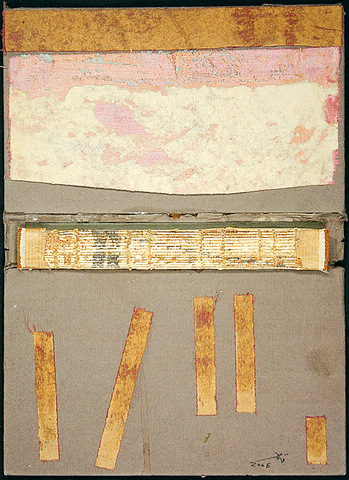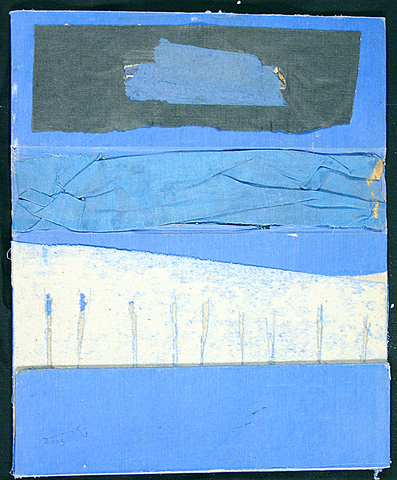Tattered book covers salvaged from the Iraqi Academy of Fine Arts and wax sketches of US bombs blowing up Baghdad are part of a rare exhibition of Iraqi artists in New York's SoHo gallery district.
Ashes to Art: The Iraqi Phoenix will be on display at the Pomegranate Gallery from today through Feb. 22.
The exhibit concentrates on subject matter from the most recent chapter of Iraq's history, beginning with the March 2003 bombing of Baghdad.

PHOTOS: AP
``The morning after that first sleepless night, I went to check on a place most dear to me, the Academy of Fine Arts,'' artist Qasim Sabti, who graduated from the academy in 1980, wrote in his statement for the exhibit.
He described entering the academy's library, which had been burned. Sabti turned books he refers to as ``survivors'' into collages by exposing and reapplying layers of their delicate bindings which are on show in the exhibit.
Hana Malallah, the lone woman among the 10 artists represented in the exhibit, submitted the painting The Looting of the Museum of Art, which she created on wood that she cut, burned and painted.

The exhibit's curator, Peter Hastings Falk, points out that a charred element exists in nearly all works in the exhibition. ``This is the aesthetic of the country,'' he said.
The idea for the exhibit began when Falk, whose expertise is in American art, became intrigued with artist Esam Pasha after reading about the artist in an August 2003 article, shortly after the US invasion of Iraq. ``He was painting over a mural of Saddam,'' Falk said.
Falk contacted the 29-year-old by e-mail and told him about his idea of organizing a show of Iraqi artists.
Pasha, a grandson of former Iraqi prime minister Nuri al-Said who was deposed and murdered in 1958, worked as a translator and language teacher, in addition to being a part of the Baghdad art scene. He helped Falk find an ethnically diverse group of Sunni, Shiite and Kurdish artists for the exhibit.
Artists in Iraq have long worked underground. Under Saddam's rule, artistic work was subject to official review. Regulations were relaxed in the 1990s, when officials were preoccupied by international sanctions, but the government began to tax the galleries. Some galleries went out of business while others just went underground.
``Art was growing its roots underneath the soil,'' Pasha said.
Sabti, the artist who salvaged books from the Academy of Fine Arts, founded the Hewar (Dialogue) Art Gallery in Baghdad in 1992, one of a few that would endure the renewed attention of Saddam. Sabti also serves as vice-president of the Iraqi Plastic Artists Society, an organization of artists with 1,780 members.
However, Iraqi artists couldn't show their work internationally without government approval, said Nada Shabout, an assistant pro-fessor specializing in contemporary Iraqi art at the University of North Texas. Uncensored work could only be found in places like Europe, where many exiled artists fled.
``The government had a strong monopoly over art,'' Shabout said in a phone interview.
Pasha recalled a time during Saddam's rule that he showed a friend a drawing he had done of an eagle falling. The friend suggested hiding the piece because the plummeting eagle ``might be interpreted as a symbol of the republic,'' he explained.
Pasha, a self-taught artist who perfected his English by watching American movies, had sold his art to UN aid workers during the 1990s embargo for around US$200 for a piece. In New York, one rendering in melted wax of the bombing of Baghdad is currently listed for US$2,400 on Falk's Web site.
Shabout, the art professor, curated an October exhibit of Iraqi contemporary art in Texas. She found visitors most surprised to find modern art existed in Iraq, and she partially blames the lack of exposure on regional stereotypes.
``It's easier to think of Iraq as the cradle of civilization,'' Shabout said.
Pasha plans to return to Baghdad eventually, and says he is optimistic about the outcome of the war. But when asked about the recent violence, including a suicide bombing that killed more than 130 people, Pasha pauses and strokes his beard. ``It does not look promising,'' he said.
On the Net:
Curator's site: www.falkart.com

June 9 to June 15 A photo of two men riding trendy high-wheel Penny-Farthing bicycles past a Qing Dynasty gate aptly captures the essence of Taipei in 1897 — a newly colonized city on the cusp of great change. The Japanese began making significant modifications to the cityscape in 1899, tearing down Qing-era structures, widening boulevards and installing Western-style infrastructure and buildings. The photographer, Minosuke Imamura, only spent a year in Taiwan as a cartographer for the governor-general’s office, but he left behind a treasure trove of 130 images showing life at the onset of Japanese rule, spanning July 1897 to

One of the most important gripes that Taiwanese have about the Democratic Progressive Party (DPP) is that it has failed to deliver concretely on higher wages, housing prices and other bread-and-butter issues. The parallel complaint is that the DPP cares only about glamor issues, such as removing markers of Chinese Nationalist Party (KMT) colonialism by renaming them, or what the KMT codes as “de-Sinification.” Once again, as a critical election looms, the DPP is presenting evidence for that charge. The KMT was quick to jump on the recent proposal of the Ministry of the Interior (MOI) to rename roads that symbolize

On the evening of June 1, Control Yuan Secretary-General Lee Chun-yi (李俊俋) apologized and resigned in disgrace. His crime was instructing his driver to use a Control Yuan vehicle to transport his dog to a pet grooming salon. The Control Yuan is the government branch that investigates, audits and impeaches government officials for, among other things, misuse of government funds, so his misuse of a government vehicle was highly inappropriate. If this story were told to anyone living in the golden era of swaggering gangsters, flashy nouveau riche businessmen, and corrupt “black gold” politics of the 1980s and 1990s, they would have laughed.

In an interview posted online by United Daily News (UDN) on May 26, current Chinese Nationalist Party (KMT) Chairman Eric Chu (朱立倫) was asked about Taichung Mayor Lu Shiow-yen (盧秀燕) replacing him as party chair. Though not yet officially running, by the customs of Taiwan politics, Lu has been signalling she is both running for party chair and to be the party’s 2028 presidential candidate. She told an international media outlet that she was considering a run. She also gave a speech in Keelung on national priorities and foreign affairs. For details, see the May 23 edition of this column,